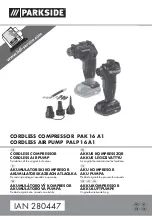
13-17-609 Page 8
1-1
SECTION 1
GENERAL INFORMATION
Figure 1-1 – COMPRESSION CYCLE
COMPRESSOR
– Your Gardner Denver Rotary Screw package is fitted with two (2) in-series single
stage, positive displacement rotary compressors using meshing helical rotors to effect compression.
Each pair of rotors is supported between high capacity anti-friction bearings located outside the
compression chamber. Single cylindrical roller bearings are used at each end of the rotors to carry the
radial loads. An additional angular contact ball bearing is located at the discharge end of each rotor to
carry axial thrust loads. The main rotor sits atop its gate companion, in an over-under configuration that
saves (compressor assembly) space and eases piping network.
COMPRESSION PRINCIPLE
(Figure 1-1) - Compression is accomplished by the main and gate rotors
synchronously meshing in a one-piece cylinder. The 1st stage main rotor has three (3) helical lobes, 120
°
apart, which mesh with five (5) helical grooves, 72
°
apart, on its matching gate rotor. The 2nd stage main
rotor has four (4) helical lobes, 90
°
apart, which mesh with five (5) helical grooves, 72
°
apart, on its gate
rotor.
The air inlet port is located on one side in of the compressor cylinder near the drive shaft end. The
discharge port is in the diametrically opposite end of the compressor cylinder. Figure 1-1,
rotates
compressor on its side to show inlet and discharge ports.
The compression cycle begins as the rotors
unmesh at the inlet port and air is drawn into the cavity between the main rotor lobes and gate rotor
grooves (A). When the rotors pass the inlet port cutoff, air is trapped in the interlobe cavity and flows
axially with the meshing rotors (B). As meshing continues, more of the main rotor lobe enters the gate
rotor groove, normal volume is reduced and pressure increases.
Oil is injected into the cylinder to remove the heat of compression and seal internal clearances. Volume
reduction and pressure continues to increase until the air/oil mixture trapped in the interlobe cavity by the
rotors passes the discharge port (C). Each rotor cavity follows the same
“fill-compress-discharge” cycle in
rapid succession to produce a discharge air flow that is continuous, smooth and shock free.
AIR FLOW IN THE COMPRESSOR SYSTEM
(Figure 4-3, page 35) - Air enters the air filters (three (3)
used) and passes through the inlet butterfly valve to the 1st stage compressor. After compression, the
air/oil mixture passes into the inter-stage manifold, where further oil injection may take place to maintain
optimal system temperature, and is subsequently delivered to the 2nd stage compressor. After 2nd stage
compression, the air/oil mixture enters the oil reservoir where most of the entrained oil is removed by
centrifugal action and drained down into the reservoir. The air and remaining aerosols pass into three (3)
coalescing elements where the oil is captured and drained through a drain line back into a lower pressure
region - the inter-stage manifold. The nearly oil-free air passes through the minimum pressure valve,
aftercooler, moisture separator, and finally to the distribution network.
Содержание VST225
Страница 36: ...13 17 609 Page 35 4 6 Figure 4 3 PIPING AND INSTRUMENTATION ILLUSTRATION 300ETW797 A Ref Drawing...
Страница 71: ...13 17 609 Page 70 8 6 FIGURE 8 4 COUPLING INSTALLATION TOOL KIT FIGURE 8 5 COUPLING REMOVAL TOOL KIT...
Страница 76: ...13 17 609 Page 75 10 3 Figure 10 2 INLET CONTROL VALVE ACTUATOR...










































